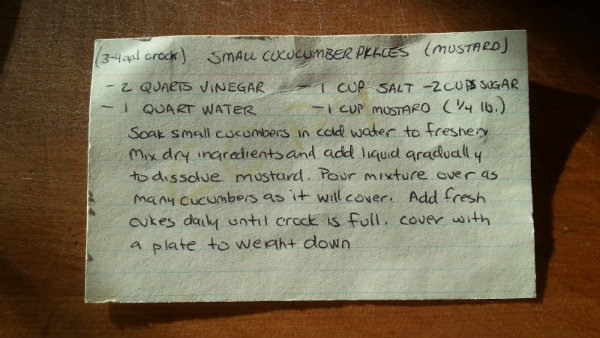A Recipe for the Mysterious Maine Mustard Pickle

Photo by Liz West CC BY
As she lifted the plate from the stoneware crock, the yellow-green briny liquid looked disgusting. The sharp vinegary smell felt like a punch in the nose. She’d scoop a small cucumber from the brine with a slotted spoon, then put it in a bowl or on a paper napkin. The pickles weren’t pretty. The older ones were an ancient dark green color and looked like they’d partially inwardly collapsed. But even the younger ones with less time in the crock had scary-looking yellow spots of dry mustard circling the tiny surface bumps of their skins.
Identifying a Maine mustard pickle is pretty easy. At first bite their distinctive reality tickles the center of the nose, followed by a sweet and surprisingly bitter crunch aimed directly at the taste buds, holding them hostage with a feeling reminiscent of drinking a very tannic tea. Depending on the length of the brine, the spiciness ranges from pleasantly soft to exuberantly sharp. It’s rare when one pickle tastes exactly the same as the last one, because the flavor depends on a lot of things: cucumber size and breed, how long it was brined, even the temperature of the room where the crock is kept.
These pickles are different from the usual dill pickle in how they taste as well as, sometimes, texture. If the mouthfeel of the usual dill pickle were to be compared to hearing a person’s voice speaking steadily in a conversational tone, the Maine mustard pickle would be that same person’s voice laughing or singing.
Maine mustard pickles are an organic force of nature — you have to live with what you get. You don’t control them, you just accept them. The delicate flavor of one with a short brine switches drastically, after a long brine time, to a pickle so puckery and strong it feels like your tongue might end up with a burn mark after eating it.
I’ve known these pickles since childhood. My grandmother made them each year, even when she lived alone in a small apartment in her old age. An earthenware pickle crock sat in a corner of her kitchen and whenever I visited (which wasn’t often — we lived far away when I was young) she’d always be sure to give me a pickle. The pickle seems to fit what Maine is, in some emotional sense. It holds true to the idea of Maine’s traditional cultural values: no-nonsense attitudes, sharp and often surprising humor, and a tolerance of individualism. Summer is short and beautiful Down East, winter is tough and usually filled with snowstorms.
-

-

-

-

-

-

-

-

-

-

-

-

-

-

-

-

-

-

-

-

-

-

-

-

-

-

-

-

-

-

-

-

-

-

-

-

-

-

-

-









































